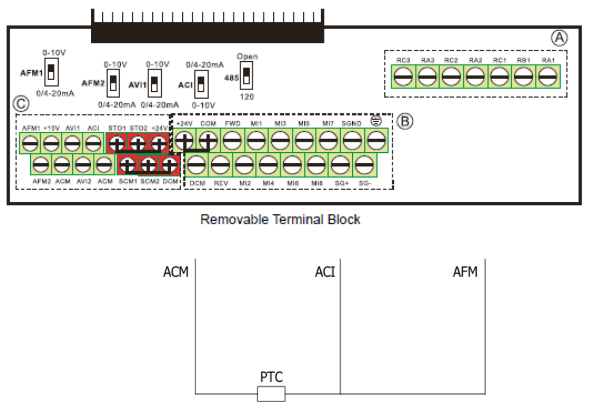Nehmen Sie einfach Kontakt mit uns auf. Sie können uns werktags zwischen 08:30 und 17:00 Uhr erreichen.
How do I connect a PTC to a C, CFP and CP2000?
Veel elektromotoren hebben tegenwoordig een ingebouwde PTC, De weerstand van deze PTC word hoger als de tempratuur van de motor toeneemt. In tegenstelling tot een PT100 kun je niet exact de tempratuur meten. De regelaar heeft een analoge ingang waar de PTC op binnenkomt. Wanneer deze een bepaalde waarde bereikt schakelt deze de motor af of geeft hier een melding van op het display.
Many electric motors nowadays have a built-in PTC. The resistance of this PTC increases when the temperature of the motor increases. Unlike a PT100, you cannot measure the temperature exactly. The controller has an analogue input where the PTC enters. When it reaches a certain value, it switches off the motor or gives a message on the display.
Schematic diagram
By connecting Figure 1: Electrical schematic, the PTC can almost be put into operation. For this, some parameters still need to be changed. More about this is described in Parameters.
AFM is the analogue output, ACI is the analogue input, ACM is ground. The AFM2 sends out a constant current.
To get everything working properly, 2 dipswitches need to be flipped for an overview. The dipswitch of ACI has to be set to 0/4-20mA . This means that the ACI measures current. The AFM's dipswitch should be set to 0/4-20mA . This means that the analogue output emits a current.


*optional parameter
The ACI input should be set as a PTC input. If the value of this input exceeds parameter 06-30, the motor switches off. Whether the motor switches off depends on parameter 06-29.
To monitor the input, it is possible to display this value on the start screen of the drive. You can do this by setting parameter 00-04 to 12. This value is in percent.
The switch-off point can be shifted using parameter 06-30. At 50%, the outside of the motor is about 75-85 °C.
Due to the characteristics of the PTC, the difference between 50% and 51% is much greater than between 30% and 35%.







